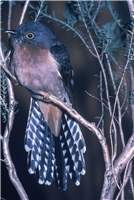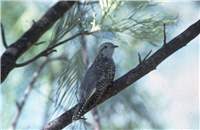Family
Cuculidae
Genus
Cacomantis
Species
flabelliformis
Threats/Control Methods - Regional
This species is vulnerable to major changes in its habitat, such as bushfires and prolonged periods of drought. Its key woodland habitat in this area is also currently threatened by land clearing for urban or agricultural developments, grazing and weed infestations.
Threats/Control Methods - Local
Within the suburbs, domestic pets threaten this species. Fragmenting reserves for roads or new buildings is also leading to a decline in this species and the thornbills that are necessary for successful breeding.
Local/Urban Actions
Cat owners can prevent their pets preying on the species by providing a stimulating indoor environment and by installing a cat run or enclosure. Collecting firewood from nature reserves or national parks should not be undertaken and gardeners can encourage the species by ensuring their yard consists of a good mix of trees, shrubs and ground litter.
Common Names
Fan-tailed Cuckoo, Ash-tailed Cuckoo
Distinguishing Features
This species is medium sized at 25-27cm and has a slender appearance. Its most distinct feature is its bright yellow eye-ring. It has a grey head and back and grey wing feathers. Its unusually long tail has a white tip and thick white stripes throughout. Male underparts are creamy cinnamon colour, while females are whiter. The young are coloured very differently, with mottled brown plumage.
Survey Techniques
Call and visual identification.
Species Call
A descending, slightly mournful musical rattle or a vibrating 'pheeweer'.
Similar Species
The Brush Cuckoo (Cacomantis variolosus) is similar in shape and size but it lacks the yellow eye-ring and has more brown colourings.
Distribution
The Fan-tailed Cuckoo is found from the northern tip of QLD right around the eastern states and across the south of Australia to WA, including TAS. The species also occurs in New Caledonia, New Guinea, Fiji, New Zealand and several islands in between.
Country of Origin
Australia
Conservation (Pet/Pest) Status - Regional
Numbers have decline significantly since 1981 (COG). This species is considered rare and sensitive (Freudenberger).
Conservation (Pet/Pest) Status - National
Secure, not listed under the EPBC Act 1999.
LSCCES Population
Three sightings were made at the ANBG.
Associated vegetation community
This species is mostly found in open forest and woodland and will also inhabit wet eucalypt forest.
Limiting Resources
This species depends upon other birds to care for their egg and their young, especially thornbills. The declining population of thornbills in the area may therefore have a direct impact on cuckoo population numbers. Both species require a woodland environment free from predators such as Cats (Felis catus) and Dogs (Canis familiaris).
Breeding
These Cuckoos will use the domed nests of other small birds, including the nests of Brown Thornbills (Acanthiza pusilla ), Yellow-rumped Thornbills (Acanthiza chrysorrhoa ), Buff-rumped Thornbills (Acanthiza reguloides ), Crested Shrike-tit (Falcunculus frontatus) and White-browed Scrubwrens (Sericornis frontalis ). The birds lay their one egg and remove one of the host's eggs. Their one egg is cream with black spots, requiring 14-15 days incubation. It usually hatches earlier than the other eggs and the host parents bring the chick up as one of their own.
Behaviour
This species is especially vocal during spring, with a distinct staccato call. To feed, it finds a good perch and then swoops down to collect an insect before returning to its perch to eat.
Functional Group
Food Species
This species will eat hairy caterpillars and other insects and their larvae.
Predators
Cats (Felis catus) and Dogs (Canis familiaris) may predate this species around suburban reserves.
Interesting Fact
The egg of the cuckoo usually hatches eariler than the other eggs in the nest, giving the chick the oppurtunity to remove the eggs of its new 'foster' parents.
References - (reader suitability of references, P=Primary teachers, S=Secondary students, T=Tertiary students and researchers)
Books:Freudenberger, D. 2001. Bush for the birds: Biodiversity enhancement guidelines for the Saltshaker Project, Boorowa, NSW. Consultancy report to Greening Australia ACT and SE NSW Inc. CSIRO Sustainable Ecosystems. Canberra. S, T
Morcombe, M. 2000. Field Guide to Australian Birds. Steve Parish Publishing. Archerfield. Australia P, S, T
Schodde, R. and Tideman, S. (eds) 1990. Reader's Digest Complete Book of Australian Birds (2nd Edition). Reader's Digest Services Pty Ltd. Sydney. P, S, T
Veerman, P. 2003. Canberra Birds: A report on the first 21 years of the garden bird survey. Philip Veerman and Canberra Ornithologists Group. Canberra. S, T
Internet: Birds in Backyards 2006. [online]. Available at:http://www.birdsinbackyards.net P, S, T
Canberra Ornithological Group (COG). 2004. Birds of Canberra Gardens. COG and the ACT Department of Urban Services. [online]. Available at:http://garden.canberrabirds.org.au/ P, S, T
Online Publications:Nix, H. and Cunningham, R. 2006. Birds of the Lower Sullivans Creek Catchment, Canberra ACT. Prepared for the Life in the Suburbs project using data from the Lower Sullivans Creek Catchment Ecological Survey (LSCCES). Australian National University. Canberra. [online]. Available at: http://www.lifeinthesuburbs.com.au/category.php?id=65 S, T



 Top
Top Top
Top